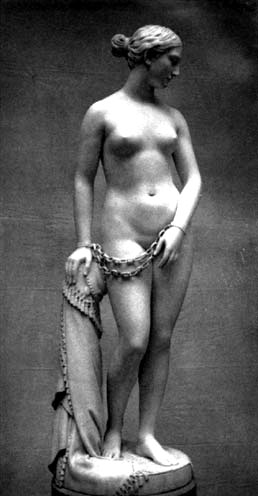Left: Lewis Carroll, Photograph of Kate Terry as Bound Woman, Collection Musée D'Orsay. Click upon photograph to obtain larger image.
Right: Benjamin Clemens, Immolate, 1912.
Many Victorian artists escaped condemnation in the public eye for depicting nudes by giving their art a title from mythology or an exotic culture. Doing so dilutes and distances the sensual nature, for as Peter Gay argues, "The more generalized and idealized the presentation of the human body in art, the more draped in elevated associations, the less likely it is to shock its viewers." Hence, even naked women in chains, such as depictions of Andromeda or slaves, found acceptance.
The myth of Andromeda found its way into artwork long before the Victorian period, and continued as a popular theme throughout the nineteenth century. William Etty and Edward Burne-Jones are just two painters who depicted Andromeda. Etty's shows an incredibly fleshy woman, quite powerful in every curve of her rounded limbs. If not for the chains, she hardly represents the victimized woman at all. Burne-Jones's Andromeda, however, has an almost androgynous quality in her thin body and narrow hips. She passively waits, helplessly exposed, as Perseus swoops in to her rescue.
This passivity became an essential quality to the bound nude, whether it be of Andromeda or no. In large sculptures, viewers feel the subject matter all the more keenly, as the three-dimensionality and size place the art more solidly in reality. Therefore, the bound female nude's passivity reaches melodrama in order to provide a more comfortable distance:
S. Nichoson Babb's The Victim , 1905.
Captive (1908), a work by a Miss J. Delahunt, is a clothed female figure... Here, the image is of passivity and acceptance, if not despair. S. Nichoson Babb's The Victim (1905), a bas relief of an Andromeda-like nude chained to a cliff, represents another standard image, popular throughout the nineteenth century, of the bound woman helplessly awaiting her fate, and Benjamin Clemens's Immolate (1912)... presents an even more extreme image of a bound nude whose nakedness is emphasized by the garment that has been peeled away from her and hangs only from her arms. The work by Delahunt represents a passively accepting woman, those by Babb and Clemens an intensification or exaggeration of that theme in the situation of the bound nude. [George P. Landow, "Margaret M. Giles's Hero and the Sublime Female Nude."]
 Notably, the chained woman's passivity was the central quality to one of the most popular sculptures of the age executed by the American sculptor Hiram Powers. His Greek Slave enjoyed a great deal of critical acclaim and public approval. Powers asserted his creation quoted historical fact: beautiful Greek women captured in conquests were often sold on the block, naked and in chains. He meant his intentions to be far from licentious, instilling in his creation the quiet dignity and inner strength and passivity of early Christian martyrs.
Notably, the chained woman's passivity was the central quality to one of the most popular sculptures of the age executed by the American sculptor Hiram Powers. His Greek Slave enjoyed a great deal of critical acclaim and public approval. Powers asserted his creation quoted historical fact: beautiful Greek women captured in conquests were often sold on the block, naked and in chains. He meant his intentions to be far from licentious, instilling in his creation the quiet dignity and inner strength and passivity of early Christian martyrs.
The Greek Slave profoundly affected the public, leading a poet H.S.C. to begin a poem: "Naked yet clothed with chastity, / She stands." This admiring sentiment certainly seemed the more prevalent one. The Greek Slave's immense popularity allowed journalists to use it as an icon to press other issues, such as the immoral slavery in the United States with the Punch cartoon depicting the "Virginian Slave." In the very next volume, Punch refers to the Greek Slave again, this time alluding to its implicit impropriety by having her and the Amazon (another popular nude) putting their clothing back on.
The two opposite usages infers a rather ambiguous feeling towards the statue. The popularity the Greek Slave and other bound nudes allowed messages of faith and the evils of slavery or victimization to be heard -- but they also satisfied the voyeuristic nature in their viewers. Gay is quick to point out that "the representation of a beautiful girl in shackles, helpless before her sensual onlookers, must have given rise to intimations of sadistic pleasures."
Other Representations of Women in Chains [GPL]
- Sir Edward Burne-Jones's The Rock of Doom
- Sir Edward Burne-Jones's The Doom Fulfilled
- "The Colour of Anxiety: Race, Sexuality and Disorder in Victorian Sculpture" [review of the exhibition at the Henry Moore Institute, London (2022-23)]
Last modified 20 April 2018


